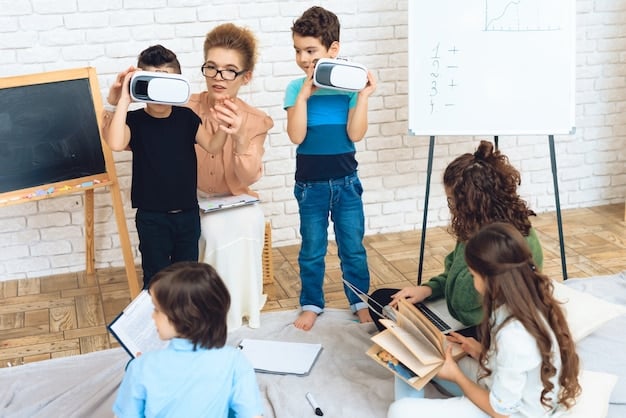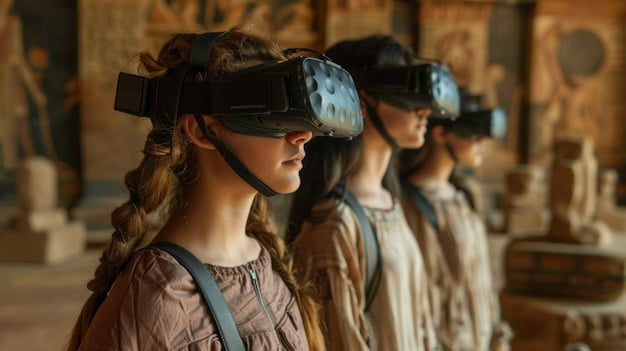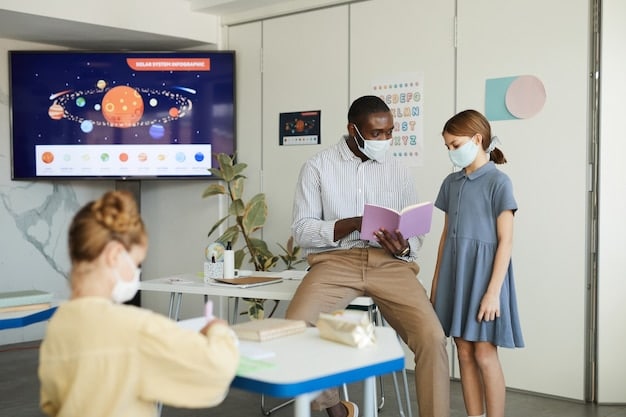The Future of Education: Trends & Tech Shaping 2025

The future of education in 2025 will be defined by personalized learning experiences enabled by AI, the integration of immersive technologies like VR/AR, and a greater focus on skills-based education to prepare students for the evolving job market.
The landscape of education is rapidly evolving, and understanding the trends and technologies that will shape it in 2025 is crucial for educators, students, and policymakers alike. The Future of Education: Exploring Emerging Trends and Technologies in 2025 promises a shift towards more personalized, accessible, and technologically integrated learning experiences.
Personalized Learning Paths: Tailoring Education to Individual Needs
Personalized learning, a concept gaining traction in education, focuses on adapting teaching methods and curriculum to suit individual student needs. This approach acknowledges that students learn at different paces and in different ways, requiring a more flexible and customized educational experience.
AI-Driven Learning Platforms
Artificial intelligence (AI) is increasingly being used to create personalized learning platforms. These platforms can analyze student performance data to identify strengths and weaknesses, tailoring content and pacing to optimize learning outcomes.
Adaptive Assessments and Feedback
Adaptive assessments provide real-time feedback to students, adjusting the difficulty level based on their performance. This ensures that students are constantly challenged but not overwhelmed, fostering a more engaging and effective learning experience.
- 📊 AI algorithms analyze student performance, pinpointing areas for improvement.
- 🎯 Personalized learning paths are created based on individual needs and goals.
- ⏱️ Adaptive assessments provide instant feedback, keeping students engaged.
- 📚 Customized content is delivered, catering to different learning styles and preferences.
In conclusion, personalized learning paths, powered by AI and adaptive assessments, have the potential to transform education by creating more effective and engaging learning experiences tailored to individual student needs.
Immersive Technologies: VR and AR in the Classroom
Immersive technologies such as virtual reality (VR) and augmented reality (AR) are poised to revolutionize education by providing students with engaging and interactive learning experiences. These technologies can transport students to different environments, making abstract concepts more tangible and understandable.

Virtual Field Trips
VR allows students to embark on virtual field trips to historical sites, museums, and other locations around the world, without leaving the classroom. This provides a unique opportunity to explore and interact with different cultures and environments.
Interactive Learning Simulations
AR can overlay digital information onto the real world, creating interactive learning simulations. For example, students can use AR apps to dissect a virtual frog or explore the human anatomy in 3D.
- 🏛️ VR field trips bring history and culture to life in an immersive way.
- 🧬 AR simulations allow for hands-on learning experiences in science and medicine.
- 🎨 Creative expression is enhanced through interactive design and art tools.
- 🌍 Global collaboration is facilitated by virtual meeting spaces and shared projects.
In conclusion, VR and AR technologies offer exciting possibilities for enhancing education by providing students with immersive and interactive learning experiences that make abstract concepts more concrete and engaging.
Skills-Based Education: Preparing Students for the Future Workforce
Skills-based education focuses on developing practical skills and competencies that are relevant to the workforce. This approach emphasizes hands-on learning, problem-solving, and critical thinking, preparing students for the challenges and opportunities of the 21st-century job market.
Emphasis on Soft Skills
In addition to technical skills, employers are increasingly valuing soft skills such as communication, teamwork, and leadership. Skills-based education programs incorporate training in these areas to ensure that students are well-rounded and prepared for the workplace.
Industry Partnerships and Internships
Collaborations with industry partners provide students with real-world learning experiences through internships, apprenticeships, and mentoring programs. These partnerships help students connect their classroom learning to practical applications.

- 🤝 Industry partnerships provide real-world learning opportunities through internships.
- 💬 Soft skills such as communication and teamwork are emphasized in the curriculum.
- 💡 Problem-solving and critical thinking skills are developed through hands-on projects.
- 💼 Career readiness programs prepare students for the job market with practical skills.
In conclusion, skills-based education plays a vital role in preparing students for the future workforce by emphasizing practical skills, soft skills, and real-world learning experiences that align with industry needs.
Gamification: Making Learning Fun and Engaging
Gamification involves incorporating game-like elements into the learning process to make it more fun and engaging. By using rewards, challenges, and competition, gamification can motivate students to learn and improve their performance.
Game-Based Learning Platforms
Game-based learning platforms offer educational content in the form of games, providing students with an interactive and immersive learning experience. These platforms can cover a wide range of subjects and skill levels.
Rewards and Recognition
Gamification often involves rewarding students for their achievements with points, badges, and other virtual rewards. This recognition can motivate students to work harder and achieve their learning goals.
- 🎮 Game-based learning platforms transform education into an engaging experience.
- 🏅 Rewards and recognition motivate students to achieve learning goals.
- 🏆 Challenges and competitions foster a sense of accomplishment and collaboration.
- 🎨 Interactive simulations enhance understanding of complex concepts.
In conclusion, gamification has the potential to make learning more engaging and effective by incorporating game-like elements that motivate students and create a fun and interactive learning environment.
Accessibility and Inclusivity: Ensuring Education for All
Accessibility and inclusivity are critical considerations in the future of education. Ensuring that all students, regardless of their background, abilities, or circumstances, have access to quality education is essential for creating a more equitable and just society.
Assistive Technologies
Assistive technologies, such as screen readers, speech recognition software, and text-to-speech tools, can help students with disabilities access and engage with educational content. These technologies can level the playing field and empower students to reach their full potential.
Culturally Responsive Teaching
Culturally responsive teaching involves incorporating students’ cultural backgrounds, experiences, and perspectives into the curriculum and teaching methods. This approach can help create a more inclusive and welcoming learning environment for all students.
- ♿ Assistive technologies provide access to education for students with disabilities.
- 🌍 Culturally responsive teaching creates an inclusive learning environment.
- 🌐 Online learning platforms expand access to education for remote students.
- 📚 Open educational resources provide affordable learning materials for all.
In conclusion, accessibility and inclusivity are essential components of the future of education, ensuring that all students have the opportunity to thrive and reach their full potential, regardless of their backgrounds or abilities.
The Role of Educators: Adapting to the Changing Landscape
As education evolves, the role of educators must also adapt to meet the changing needs of students and the demands of the 21st-century workforce. Educators will increasingly need to serve as facilitators, mentors, and guides, helping students navigate the complex and ever-changing landscape of learning.
Professional Development and Training
Ongoing professional development and training are essential for educators to stay up-to-date with the latest trends and technologies in education. This includes training in personalized learning, immersive technologies, and skills-based education.
Collaboration and Networking
Collaboration and networking among educators can foster the sharing of best practices and innovative ideas. By working together, educators can create a more vibrant and effective learning community.
- 👩🏫 Educators must adapt their roles to become facilitators and mentors.
- 📚 Professional development provides training in the latest educational trends.
- 🤝 Collaboration and networking foster innovation and best practices.
- 🌱 Cultivating a supportive learning environment is crucial for student success.
In conclusion, the role of educators in the future of education will be more critical than ever, requiring them to adapt to the changing landscape and serve as facilitators, mentors, and guides for their students.
| Key Trends | Brief Description |
|---|---|
| 🤖 Personalized Learning | AI tailors education to individual needs, optimizing learning outcomes. |
| 👓 Immersive Technologies | VR/AR enhance learning with virtual field trips and interactive simulations. |
| 💼 Skills-Based Education | Focus on practical skills and industry partnerships for workforce readiness. |
| 🎮 Gamification | Game-like elements make learning fun, motivating students with rewards and challenges. |
Frequently Asked Questions (FAQ)
▼
AI analyzes student data to identify strengths and weaknesses, tailoring content and pacing. This ensures each student receives a customized education, optimizing their learning outcomes and addressing specific needs.
▼
VR enables virtual field trips, offering immersive experiences, while AR overlays digital information onto the real world for interactive simulations. Together, they make abstract concepts tangible and enhance engagement.
▼
Skills-based education develops practical competencies relevant to the workforce, emphasizing soft skills and hands-on learning. This prepares students for the challenges and opportunities of the 21st-century job market.
▼
Gamification incorporates game-like elements, such as rewards and challenges, to make learning more fun and engaging. This motivates students, fostering a sense of accomplishment and enhancing their overall educational experience.
▼
Assistive technologies include screen readers, speech recognition software, and text-to-speech tools. These technologies help students with disabilities access and engage with educational content, promoting inclusivity and equal opportunities.
Conclusion
As we look towards 2025, the future of education promises transformative changes driven by emerging trends and technologies. From personalized learning paths and immersive VR/AR experiences to skills-based curricula and inclusive practices, the focus is on creating effective and engaging learning environments for all students, preparing them for success in a rapidly evolving world.





